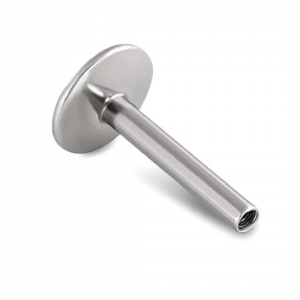When it comes to body jewelry, one debate always sparks discussion: internally threaded vs. externally threaded. What’s the real difference between the two? If you want jewelry that’s safe, comfortable, and promotes optimal healing, understanding the facts is essential. Here’s everything you need to know to make the right choice for your piercings.
What Is Threaded Piercing Jewelry?

Threaded piercing jewelry includes any piece that screws together—such as barbells, labret piercings, and other threaded body jewelry. The threading refers to the way the decorative end and the shaft of the jewelry are connected. The threads serve as a locking mechanism to keep the jewelry secure.
Understanding the difference between internally threaded and externally threaded jewelry can make a big difference in comfort and healing, especially if you’re getting a new labret piercing or any other sensitive body modification.
Internally Threaded Body Jewelry

In internally threaded piercing jewelry, the shaft contains a smooth, hollow opening (the “female” end) where the “male” part—attached to the decorative end—screws in.
Benefits of Internally Threaded Piercing Jewelry
- Less Trauma to the Piercing: Since the threads are hidden inside the shaft, the jewelry passes through the piercing more smoothly without scraping the delicate tissue.
- Ideal for New Piercings: The smooth exterior minimizes friction and irritation, which makes internally threaded jewelry the preferred choice for fresh piercings.
- Better for Sensitive Areas: For piercings in areas like the nipple or genital region, internally threaded jewelry reduces discomfort during insertion and healing.
Risk of Internally Threaded Piercing Jewelry
- Cost: Internally threaded jewelry can be slightly more expensive because it’s more complex to manufacture.
- Availability: Not all shops carry a wide variety of internally threaded options, especially for less common piercing types.
Externally Threaded Body Jewelry
Externally threaded piercing jewelry has the threads on the outside of the shaft. The “male” part is on the shaft, and the decorative end has the “female” opening where it screws in.
Benefits of Externally Threaded PiercingJewelry
- Affordability: Externally threaded jewelry is often more budget-friendly because it’s easier to produce.
- Easier to Find: Most piercing shops and online retailers offer a wide range of externally threaded options.
- Versatility: Externally threaded jewelry comes in a broad range of designs and materials.
Risk of Externally Threaded Piercing Jewelry
- Increased Discomfort: The exposed threads can scrape and irritate the skin during insertion, especially with fresh piercings.
- Higher Risk of Infection: The rough surface created by external threading can harbor bacteria, increasing the chance of infection or prolonged healing times.
Why Internally Threaded Jewelry Is Better for New Piercings
If you’re getting a new piercing—especially in a sensitive area—internally threaded jewelry is the way to go. For example, a labret piercing benefits greatly from internally threaded jewelry since it reduces the risk of trauma and speeds up the healing process.
With internally threaded jewelry, there’s less friction as the jewelry passes through the piercing channel. This lowers the risk of micro-tears, which are often the entry point for bacteria and can lead to infections.
When Does External Threading Work?
 While internally threaded jewelry is ideal for new piercings, external threading isn’t necessarily a dealbreaker for healed piercings. If your piercing is fully healed and in a less sensitive area (like the earlobe or tongue), external threading can work just fine.
While internally threaded jewelry is ideal for new piercings, external threading isn’t necessarily a dealbreaker for healed piercings. If your piercing is fully healed and in a less sensitive area (like the earlobe or tongue), external threading can work just fine.
Also, using a taper during insertion can help prevent any scraping or damage. When switching from an externally threaded barbell to an internally threaded one, you can screw the jewelry onto a taper, slide it through the piercing, and then unscrew the taper—eliminating direct contact with the threads.
Piercing Aftercare Tips
Regardless of whether you choose internally or externally threaded jewelry, proper aftercare is essential:
- Clean your piercing twice daily with a sterile saline solution.
- Avoid touching or rotating the jewelry unnecessarily.
- If you notice swelling, redness, or discharge, consult your piercer or a healthcare provider.
Find out everything you need to know in our piercing aftercare blog here.

The Verdict: Internally Threaded Wins for New Piercings
For new piercings, internally threaded jewelry is the clear winner. It’s more comfortable, reduces trauma, and speeds up healing. However, for healed piercings, externally threaded jewelry is still a solid option—especially if you’re looking for a more affordable piece or a specific design. Moreover, you can also try threadless jewelry for new or healed piercings. Learn all about threadless body jewelry in this blog here.
BOTTOM LINE? For new piercings, go internal (or threadless). For healed piercings, do what feels right—but always prioritize comfort and quality.


Comments are closed here.